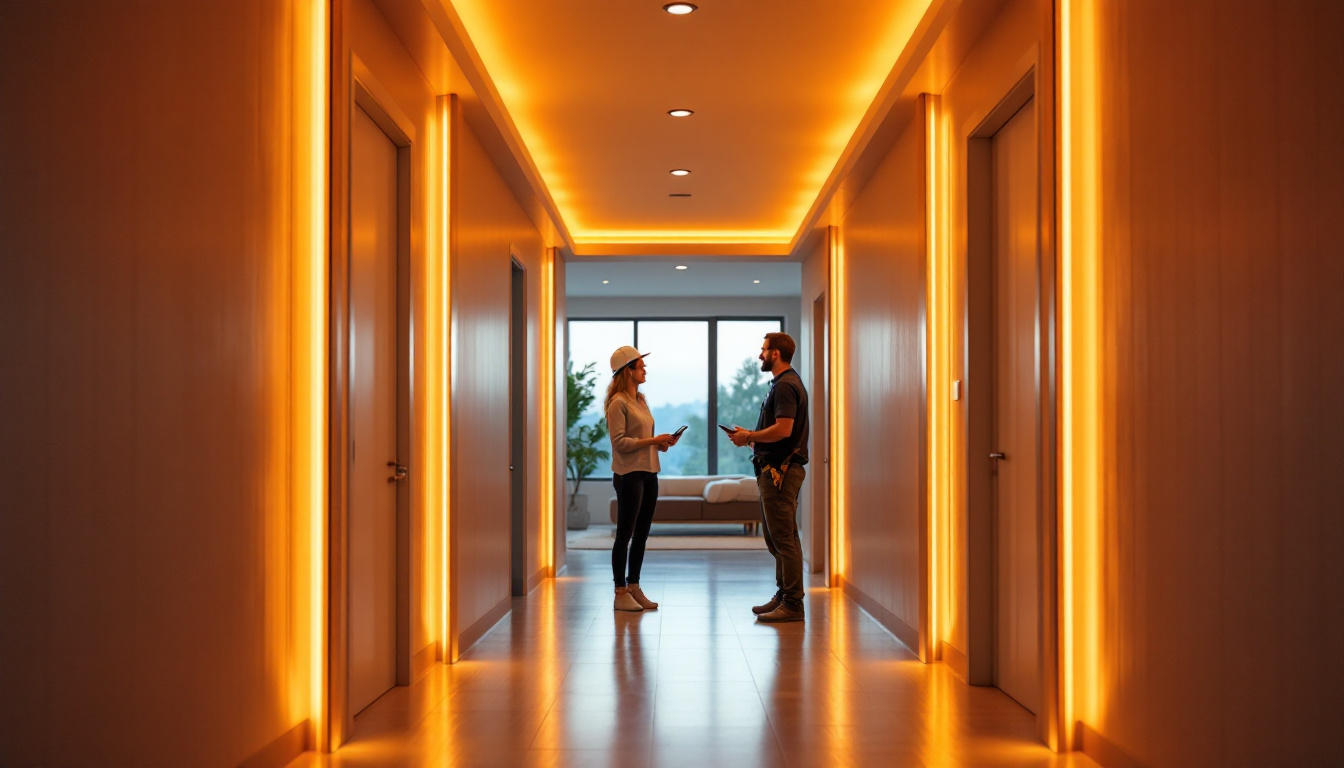
In recent years, the shift towards energy-efficient lighting solutions has gained significant momentum, particularly in commercial and residential spaces. Among the various options available, LED hallway lights have emerged as a favored choice for many lighting contractors. This article delves into the innovative approaches that contractors can adopt when integrating LED hallway lighting into their projects, emphasizing the benefits, installation techniques, and design considerations.
LED (Light Emitting Diode) technology has revolutionized the lighting industry, offering numerous advantages over traditional lighting methods. Understanding the fundamentals of LED technology is crucial for lighting contractors aiming to provide clients with the best solutions.
One of the most compelling reasons to choose LED hallway lights is their energy efficiency. LEDs consume significantly less power compared to incandescent or fluorescent bulbs, translating to lower energy bills for clients. This efficiency is particularly beneficial in hallways, which often require continuous lighting.
Moreover, the long lifespan of LEDs—often exceeding 25,000 hours—means that replacements are infrequent. This longevity not only reduces maintenance costs but also minimizes waste, making LEDs an environmentally friendly option. In fact, the reduced energy consumption of LEDs contributes to a lower carbon footprint, aligning with sustainability goals that many businesses and homeowners are now prioritizing.
LEDs provide excellent color rendering capabilities, which is essential in spaces where accurate color perception is necessary. This feature enhances the aesthetic appeal of hallways, making them more inviting and visually appealing.
Additionally, LEDs are available in a variety of color temperatures, allowing contractors to customize the ambiance of hallways according to the client’s preferences. Whether a warm, cozy glow or a bright, energizing light is desired, LEDs can meet those needs. Furthermore, the ability to dim LED lights adds another layer of versatility, enabling users to adjust the brightness based on the time of day or specific activities taking place in the hallway. This adaptability not only enhances comfort but also contributes to energy savings by allowing for lower light levels when appropriate.
Furthermore, the compact size of LED fixtures allows for innovative designs that can fit into various architectural styles. This flexibility means that lighting contractors can create unique lighting solutions that complement the overall design of a space, whether it be modern, traditional, or somewhere in between. The integration of smart technology with LED lighting also opens up possibilities for automation and remote control, providing users with enhanced convenience and control over their lighting environment.
Proper installation is crucial for maximizing the benefits of LED hallway lights. Contractors must be well-versed in various installation techniques to ensure optimal performance and aesthetics.
Before installation begins, careful planning of the lighting layout is essential. This involves determining the appropriate spacing between fixtures to achieve even illumination throughout the hallway. Factors such as the width of the hallway, the height of the ceiling, and the intended use of the space should be taken into account.
Using lighting design software can aid in visualizing the layout and ensuring that the light distribution meets the desired standards. This proactive approach helps avoid common pitfalls associated with inadequate lighting, such as dark spots or overly bright areas. Furthermore, considering the color temperature of the LEDs can significantly impact the ambiance of the hallway. Warmer tones may create a welcoming atmosphere, while cooler tones can enhance visibility and alertness, making it essential to select the right hue for the intended environment.
When installing LED hallway lights, attention must be paid to the wiring. LEDs operate on low voltage, and improper wiring can lead to flickering or reduced lifespan. Contractors should ensure that the wiring is compatible with the LED fixtures being installed.
Additionally, incorporating smart lighting controls can enhance the functionality of LED hallway lights. Dimmers, motion sensors, and timers can be integrated into the wiring system, allowing for greater control over energy consumption and lighting levels. This not only contributes to energy efficiency but also enhances safety by ensuring that lights are activated when needed, such as when someone enters the hallway. Moreover, using conduit or raceways for wiring can protect the electrical components from damage and provide a cleaner, more organized appearance, which is particularly important in high-traffic areas.
Design plays a pivotal role in the effectiveness of LED hallway lighting. Contractors should consider various factors that influence both functionality and aesthetics.
The choice of fixtures is critical when designing LED hallway lighting. Options range from recessed lights to surface-mounted fixtures, each offering distinct advantages. Recessed lights provide a sleek, unobtrusive look, while surface-mounted fixtures can serve as decorative elements.
Contractors should also consider the style and finish of the fixtures to ensure they complement the overall design of the space. A well-chosen fixture can enhance the hallway’s character and contribute to the overall ambiance. For instance, vintage-style fixtures can add a touch of elegance to a traditional home, while minimalist designs may be more suitable for modern or industrial spaces. Furthermore, the placement of these fixtures is equally important; strategically positioning them can help eliminate shadows and create a more inviting environment.
As mentioned earlier, the color temperature of LED lights can significantly impact the mood of a hallway. Generally, warmer temperatures (2700K-3000K) create a cozy atmosphere, while cooler temperatures (4000K-5000K) promote alertness and energy.
Contractors should discuss these options with clients to determine the most suitable color temperature for their specific needs. Additionally, brightness levels should be adjusted based on the hallway’s function—higher brightness may be necessary in busy commercial spaces, while softer lighting may be preferred in residential settings. It’s also worth considering the use of dimmable LED options, which allow for flexibility in lighting levels depending on the time of day or specific activities taking place in the hallway. This adaptability can be especially beneficial in multi-use spaces, where the lighting requirements may change throughout the day.
Moreover, the integration of smart lighting technology can enhance the functionality of hallway lighting systems. Smart LED fixtures can be programmed to adjust brightness and color temperature automatically based on occupancy or the time of day, providing both energy efficiency and convenience. This feature not only promotes sustainability but also allows for a personalized lighting experience, catering to the preferences of different users in the space. As technology continues to evolve, incorporating these advanced systems can future-proof hallway designs, ensuring they remain relevant and effective for years to come.
The integration of smart technology into LED hallway lighting is a growing trend that contractors should embrace. Smart lighting solutions offer enhanced control, convenience, and energy savings.
Smart lighting systems allow for automation of hallway lights, enabling them to turn on or off based on occupancy or time of day. Motion sensors can detect movement, ensuring that lights are only activated when needed, which further enhances energy efficiency.
Moreover, smart lighting can be controlled remotely through mobile applications, giving clients the ability to adjust settings from anywhere. This level of control not only adds convenience but also enhances security, as homeowners can program lights to mimic occupancy while away.
LED hallway lights can be seamlessly integrated with other smart home devices, such as security systems and smart thermostats. This interconnectedness allows for coordinated responses to various scenarios—for example, hallway lights can be programmed to illuminate when a security camera detects movement.
Contractors should stay informed about the latest smart home technologies and offer clients comprehensive solutions that enhance their overall living experience.
While LED hallway lights are known for their longevity, occasional maintenance and troubleshooting may be necessary. Contractors should be prepared to address common issues that may arise.
Conducting regular inspections of LED hallway lights is essential to ensure optimal performance. This includes checking for any flickering, dimming, or color inconsistencies. Identifying these issues early can prevent more significant problems down the line.
Additionally, cleaning the fixtures and lenses can help maintain brightness and clarity. Dust and debris can accumulate over time, diminishing the effectiveness of the lighting.
In the event of flickering lights, contractors should first check the wiring connections to ensure they are secure. If the issue persists, it may be necessary to replace the driver or transformer, as these components can wear out over time.
For dimming issues, compatibility between the LED fixtures and the dimmer switch should be verified. Not all dimmers are suitable for LED lights, and using incompatible dimmers can lead to performance problems.
When proposing LED hallway lighting solutions to clients, cost considerations are paramount. While the initial investment may be higher than traditional lighting options, the long-term savings can be substantial.
The upfront cost of LED fixtures and installation can be a deterrent for some clients. However, it is essential to highlight the long-term savings associated with reduced energy consumption and maintenance costs. Over time, these savings can offset the initial investment, making LEDs a financially sound choice.
Additionally, many utility companies offer rebates or incentives for installing energy-efficient lighting, which can further reduce the financial burden on clients.
Integrating smart technology into LED hallway lighting may require additional investment. Contractors should provide clients with a clear breakdown of costs associated with smart controls, sensors, and integration with other devices.
Emphasizing the benefits of smart technology, such as increased convenience and energy savings, can help clients see the value in the additional expenditure.
LED hallway lights represent a significant advancement in lighting technology, offering numerous benefits for both contractors and clients. By understanding the intricacies of LED technology, employing effective installation techniques, and embracing smart solutions, lighting contractors can elevate their projects and provide exceptional value.
As the demand for energy-efficient and aesthetically pleasing lighting solutions continues to grow, staying informed about the latest trends and technologies will be crucial for contractors looking to thrive in this competitive market. The future of hallway lighting is bright, and LED technology is at the forefront of this evolution.
Ready to take your lighting projects to the next level? LumenWholesale is here to light the way. Our commitment to providing contractors with superior, spec-grade LED hallway lights and other lighting products at wholesale prices means you can deliver excellence without compromise. With our direct-to-consumer approach, you avoid inflated markups and enjoy the benefits of high-quality, energy-efficient lighting solutions. Plus, with free shipping on bulk orders, you can stock up on everything you need while keeping costs low. Elevate your lighting game and give your clients the best value by visiting Wholesale Lighting at the Best Value today.

Discover why lighting contractors should prioritize replacing overhead lights with LEDs in business settings.

Discover how strategic stairwell lighting can elevate the success of lighting contractors.

Discover the must-have 8-foot LED bulbs that are revolutionizing the lighting industry for contractors.

Discover the ultimate resources lighting contractors rely on to master office light fixtures.